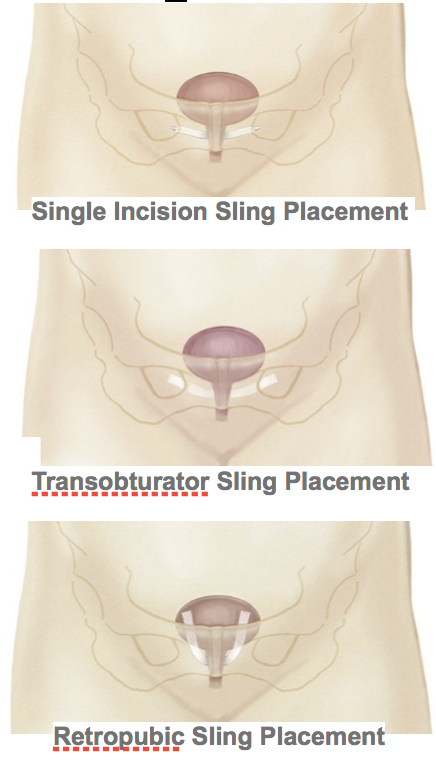URETHRAL SLING PROCEDURE
Your minimally-invasive sling procedure is estimated to only take 30–45 minutes. A small incision will be made in the vaginal area. Next, the synthetic mesh is placed to create a “sling” of support around the urethra.When your doctor is satisfied with the position of the mesh, he or she will close and bandage the small incisions in the groin area (if applicable for your sling type) and the top of the vaginal canal.Before your discharge from the hospital, you may be given a prescription for an antibiotic and/or pain medication to relieve any discomfort you may experience. You will be instructed on how to care for your incision area.At the discretion of your physician, most patients resume moderate activities within 2 to 4 weeks, with no strenuous activity for up to 6 weeks.Most women see results right after the procedure. Talk with your physician about what you should expect. You will need to abstain from sexual intercourse for 6 weeks post op.
RISKS
These are the commoner risks. There may be other unusual risks that have not been listed here. Please ask you surgeon if you have any general or specific concerns.There are risks associated with any anaesthetic, you may have side effects from any drugs used. The commoner sideeffects include light-headedness, nausea, skin rash and constipation.
Some potential adverse reactions related to surgical correction for stress urinary incontinence include:
- Pain/Ongoing Pain/Discomfort/Irritation
- Inflammation (redness, heat, pain, or swelling resulting from surgery)
- Edema (swelling caused by fluid retention) and erythema (redness of the skin) at the wound site
- Infection, including abscess
- Bleeding (vaginal) and hematoma formation (pooling of blood beneath the skin)
- Scarring/scar contracture
- Mesh erosion (presence of mesh material within the organs surrounding the vagina)
- Mesh extrusion (presence of mesh materials within the vagina)
- Fistula formation (a hole/passage that develops between organs or anatomic structures that is repaired by surgery)
- Foreign body response and allergic reaction to mesh implant
- Urinary incontinence (involuntary leaking of urine)
- Urinary retention/obstruction (involuntary storage of urine/blockage of urine flow)
- Voiding dysfunction (difficulty with urination)
- Vaginal discharge
- Dehiscence of vaginal incision (opening of the incision after surgery)
- Nerve damage
- Detrusor instability (involuntary contraction of the detrusor muscle while the bladder is filling)
- Device migration, complete failure of the procedure
- Dyspareunia (pain during intercourse)
Some of the above risks are more likely if you smoke, are overweight, diabetic, have high blood pressure or have had previous heart disease.
When you are discharged, take care of the following:
- You may have pain or discomfort in your vaginal area or legs for a few moths
- Light bleeding or discharge from the vagina is normal
- Keep a dry dressing over the incision, change the dressing as needed (as instructed by your doctor) (mini sling does not have any dressing)
- You may shower after your surgery, showers are better than baths for a few weeks until your incision has healed.
- Refrain from sexual activities for 6 weeks.
- Refrain from exercise, physical activity & straining; driving for 4 – 6 weeks
- Try to prevent constipation by eating foods with a lot of fibre.
- Use stool softeners as prescribed by your doctor, straining during bowel movements will put pressure on your incision
- Drink extra fluids to help keep your stools loose
Please call the doctor if you experience any of the following:
- Severe pain
- Fever
- Heavy vaginal bleeding
- Vaginal discharge with an odour
- A lot of blood in your urine
- You have signs of infection (a burning sensation when you urinate, fever or chills)
